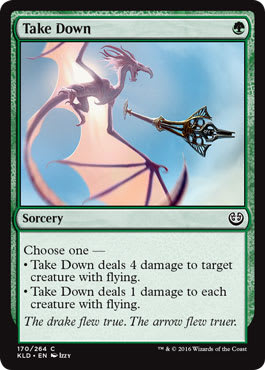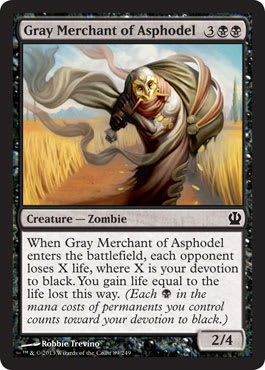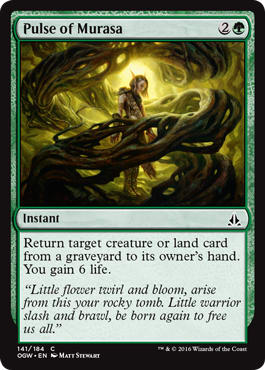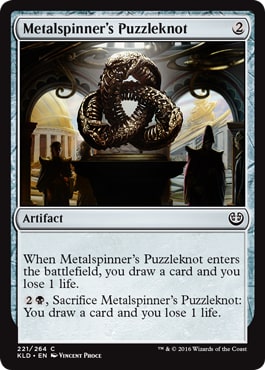The day after this article goes live Peregrine Drake will no longer be legal in Pauper. After five months the format will have the opportunity to see other decks rise and see what other gems were hidden in Eternal Masters, Eldritch Moon, and Kaladesh. That is not to say one has to approach tomorrow completely unprepared. Using information from the time before Eternal Masters allows us to sketch out the first days of new Pauper. Why? Even though there have been three sets introduced since Shadows over Innistrad Pauper has a high barrier for entry — it’s tough for new cards to make it through.
Before diving into what tomorrow brings let’s take a look at the immediate past. Peregrine Drake decks were an unprecedented force in Pauper. As of the time of writing Peregrine Drake decks accounted for almost 27% of all undefeated decks since it became legal. The next best decks were Affinity, Delver, and Stompy. In that same span those decks comprised 11.85%, 10.27%, and 9.28% of the undefeated metagame respectively. These decks are not going to disappear overnight as they were all factors in the pre-Drake metagame. Delver (20.04%) and Stompy (15.59%) were the top two decks for the weeks between Shadows over Innistrad and Eternal Masters. Affinity clocked in at 6.88% so while it was still a factor it was not top contender. That being said I expect the first week of new Pauper to be heavy on Affinity.
Affinity is likely the most broken deck left in the format. The ability to cast large creatures for a drastically reduced cost while also having access to an “I win” combo in Atog-Fling cannot be underrated. If the deck is so strong then why were its pre-Drake numbers simply good and not great?
First, Affinity is subject to some of the most severe hate available in Pauper. Beyond Gorilla Shaman (which is a strong enough card that I never want to run Affinity) there are cards like Natural State, Gleeful Sabotage, Fragmentize, Smelt, Smash to Smithereens, Ancient Grudge, Annul, Steel Sabotage, and on and on and on. It is easy to contain Affinity with hate provided that one can dedicate some number of sideboard slots and see their expected win percentage go up. When almost everyone does this the format becomes extremely hostile to Affinity.
In the Peregrine Drake metagame it was not easy to do this. The format devolved to Drake decks and those that could race. As such cards that did not actively help you win the game and instead only delayed opposing victory fell out of favor. Gorilla Shaman might be a slam dunk but when Smash to Smithereens only costs two and comes with a Lava Spike it gets slightly more attractive. Because the format turned into one where racing mattered Affinity was able to establish a firm foothold.
Affinity ? Pauper | BingBlangBlaow, 5-0 Pauper League 11/12/16
- Creatures (17)
- 1 Gearseeker Serpent
- 4 Atog
- 4 Carapace Forger
- 4 Frogmite
- 4 Myr Enforcer
- Spells (27)
- 2 Fling
- 2 Perilous Research
- 4 Galvanic Blast
- 4 Thoughtcast
- 2 Flayer Husk
- 2 Ichor Wellspring
- 3 Prophetic Prism
- 4 Chromatic Star
- 4 Springleaf Drum
- Lands (16)
- 1 Ancient Den
- 3 Darksteel Citadel
- 4 Great Furnace
- 4 Seat of the Synod
- 4 Tree of Tales
- Sideboard (15)
- 4 Ancient Grudge
- 1 Apostle's Blessing
- 2 Electrickery
- 1 Feed the Clan
- 2 Pyroblast
- 1 Ray of Revelation
- 4 Relic of Progenitus
Second, Affinity has struggled when removal heavy decks can come prepared. In the past a deck like Mono-Black Control, with its ability to deal with every presented threat, helped to keep Affinity in check. Dead Weight, Chainer's Edict, and Victim of Night operate on the same curve as Atog, Carapace Forger, and Myr Enforcer. The ability to then go over the top with Gray Merchant of Asphodel also allows MBC to build a position where it can win off the top.
Mono-Black Control, Pauper | ccezar, 5-0 Pauper League 10/12/16
- Creatures (14)
- 3 Liliana's Specter
- 3 Phyrexian Rager
- 4 Cuombajj Witches
- 4 Gray Merchant of Asphodel
- Spells (24)
- 1 Disfigure
- 1 Doom Blade
- 4 Geth's Verdict
- 4 Victim of Night
- 2 Chainer's Edict
- 2 Duress
- 4 Sign in Blood
- 4 Wrench Mind
- 2 Pestilence
- Lands (22)
- 18 Swamp
- 1 Bojuka Bog
- 3 Barren Moor
- Sideboard (15)
- 1 Disfigure
- 3 Doom Blade
- 2 Duress
- 2 Corrupt
- 1 Crypt Incursion
- 3 Diabolic Edict
- 1 Relic of Progenitus
- 2 Shrivel
Jeskai Midrange also is a deck heavy on removal. With Flame Slash, Lightning Bolt, Galvanic Blast, and Journey to Nowhere, Jeskai had a solid defensive curve. The fact that it can access Gorilla Shaman, Ancient Grudge, and Kor Sanctifiers doesn’t hurt the matchup either. In the past the deck has relied on smaller creatures to win but the addition of Gearseeker Serpent may change that.
Jeskai Midrange ? Pauper | GLNemesis, 5-0 Pauper League 11/12/16
- Creatures (17)
- 1 Lone Missionary
- 2 Gearseeker Serpent
- 2 Mulldrifter
- 4 Glint Hawk
- 4 Kor Skyfisher
- 4 Thraben Inspector
- Spells (23)
- 4 Galvanic Blast
- 4 Lightning Bolt
- 1 Angelic Purge
- 4 Kuldotha Rebirth
- 2 Journey to Nowhere
- 4 Ichor Wellspring
- 4 Prophetic Prism
- Lands (20)
- 1 Azorius Chancery
- 1 Boros Garrison
- 1 Izzet Boilerworks
- 1 Mortuary Mire
- 1 Swiftwater Cliffs
- 1 Tranquil Cove
- 2 Wind-Scarred Crag
- 4 Ancient Den
- 4 Great Furnace
- 4 Seat of the Synod
- Sideboard (15)
- 1 Lone Missionary
- 2 Electrickery
- 3 Gorilla Shaman
- 2 Hydroblast
- 4 Pyroblast
- 3 Standard Bearer
These decks were largely absent from the metagame thanks to Peregrine Drake. Mono-Black and Jeskai both rely on trading one-for-one early and slowly building an overwhelming advantage. Devotion for Gray Merchant of Asphodel or pointing Galvanic Blasts at a life total are both great ways to win but they take time. Peregrine Drake decks could completely obsolete one-for-one trades with Ghostly Flicker and Mulldrifter. Drake also turned off sorcery speed removal and hindered these decks. Now with both of these decks being presented as viable options it should help to keep Affinity in check.
Delver and Stompy should remain contenders. These decks have a consistency borne out of redundancy and solid mana. While both have at times struggled against removal heavy decks I do not doubt they will be at or near the top of the standings. Stompy, in particular, has adopted a build that is far more resilient to removal with cards like Young Wolf and Hunger of the Howlpack. These cards allow Stompy to craft a larger threat that, when protected with Vines of Vastwood, can prove hard to remove. Early on I would imagine the Green deck to represent the clock of the format in that it will be the best performing deck that wins via damage.
Stompy ? Pauper | Heagyth, 5-0 Pauper League 11/10/16
- Creatures (27)
- 1 Mire Boa
- 2 Garruk's Companion
- 2 Nest Invader
- 2 River Boa
- 2 Silhana Ledgewalker
- 4 Nettle Sentinel
- 4 Quirion Ranger
- 4 Skarrgan Pit-Skulk
- 4 Young Wolf
- 2 Vault Skirge
- Spells (17)
- 2 Mutagenic Growth
- 3 Hunger of the Howlpack
- 4 Groundswell
- 4 Vines of Vastwood
- 4 Rancor
- Lands (16)
- 16 Forest
- Sideboard (15)
- 1 Epic Confrontation
- 2 Feed the Clan
- 3 Gleeful Sabotage
- 3 Gut Shot
- 3 Natural State
- 3 Scattershot Archer
Delver ? Pauper | snackysnek, 5-0 Pauper League 11/10/16
- Creatures (21)
- 2 Pestermite
- 3 Spire Golem
- 4 Delver of Secrets
- 4 Faerie Miscreant
- 4 Ninja of the Deep Hours
- 4 Spellstutter Sprite
- Spells (22)
- 1 Deprive
- 1 Dispel
- 1 Exclude
- 1 Gush
- 1 Vapor Snag
- 2 Daze
- 3 Snap
- 4 Counterspell
- 4 Ponder
- 4 Preordain
- Lands (17)
- 17 Island
- Sideboard (10)
- 1 Dispel
- 1 Exclude
- 2 Annul
- 3 Curse of Chains
- 3 Hydroblast
But these are the established decks. What does the change mean for strategies beyond the top?
Pauper is going to slow down. As mentioned one way people tried to beat Drake decks was by racing. Because of this the Khans of Tarkir gainlands have seen reduced play as they can cause decks to sputter early. The absence of Peregrine Drake means that other decks have viable end game options. In turn the gainlands get significantly better and decks that are trying to deal damage see a dip in their efficacy. The cumulative effect of multiple decks running incidental life gain means the average life total will be higher than 20. This does not take into account the potential rise of Jeskai Midrange decks, some of which run Lone Missionary main.
I fully expect decks built for the long game to reemerge. Pauper has access to plenty of cards that are capable of drawing out a game and building small advantages. As removal gets better so to do cards that can retrieve creatures late. Font of Return and Pulse of Murasa should have a chance to shine once more. Both of these cards are also reasonable targets for Auramancer or Archaeomancer. While Pulse can play nicely with Mnemonic Wall, Font of Return may mean more copies of Monastery Loremaster seeing play. Together these cards create an overwhelming endgame that is far less taxing on deck construction than Tortured Existence.
Murasa Tron ? Pauper | Lorac, 5-0 Pauper League 11/8/16
- Creatures (9)
- 2 Mnemonic Wall
- 3 Sea Gate Oracle
- 4 Mulldrifter
- Spells (28)
- 1 Capsize
- 1 Echoing Truth
- 1 Ghostly Flicker
- 2 Counterspell
- 2 Lightning Bolt
- 2 Mystical Teachings
- 2 Pulse of Murasa
- 4 Condescend
- 1 Rolling Thunder
- 2 Chainer's Edict
- 2 Compulsive Research
- 3 Flame Slash
- 1 Expedition Map
- 4 Prophetic Prism
- Lands (23)
- 3 Island
- 1 Izzet Guildgate
- 1 Shimmering Grotto
- 2 Dismal Backwater
- 4 Swiftwater Cliffs
- 4 Urza's Mine
- 4 Urza's Power Plant
- 4 Urza's Tower
- Sideboard (15)
- 1 Ancient Grudge
- 1 Diabolic Edict
- 2 Dispel
- 2 Gorilla Shaman
- 2 Hydroblast
- 1 Magma Spray
- 2 Negate
- 3 Pyroblast
- 1 Ulamog's Crusher
Murasa Sultai ? Pauper | Alex Ullman, Proposed Pauper Deck
- Creatures (13)
- 1 Crypt Rats
- 1 Gurmag Angler
- 1 Monastery Loremaster
- 1 Twisted Abomination
- 2 Thraben Foulbloods
- 3 Phyrexian Rager
- 4 Chittering Rats
- Spells (24)
- 1 Complete Disregard
- 1 Snuff Out
- 2 Doom Blade
- 2 Grasp of Darkness
- 2 Tragic Slip
- 3 Pulse of Mirasa
- 1 Raven's Crime
- 2 Chainer's Edict
- 2 Read the Bones
- 1 Font of Return
- 2 Dead Weight
- 1 Executioner's Capsule
- 4 Metalspinner's Puzzleknot
- Lands (23)
- 1 Forest
- 1 Island
- 10 Swamp
- 1 Bojuka Bog
- 1 Dimir Aqueduct
- 1 Dismal Backwater
- 1 Golgari Rot Farm
- 1 Remote Isle
- 1 Slippery Karst
- 2 Warped Landscape
- 3 Jungle Hollow
- Sideboard (15)
- 3 Duress
- 3 Aerial Volley
- 3 Wickerbough Elder
- 2 Crypt Rats
- 2 Nihil Spellbomb
- 1 Take Down
- 1 Dead Weight
In testing in preparation for the change I have heavily advocated for Metalspinner's Puzzleknot over Night's Whisper. Early in the new metagame I would keep on this path. Puzzleknot has an advantage in that it splits up both the draw and life loss. In metagames without significant aggression being able to cast Night's Whisper (and even Sign in Blood) is fine as the life lost matters far less. Pauper, despite the fact it is going to slow down by a turn or so, still features a huge number of aggressive decks. The ability to see a new card while saving a draw for later is immensely valuable as it allows for increased control of a life total. There will be times where the extra mana is a huge liability but I’m eager to try out the Puzzleknot.
I also think that cards like Avarax and Self-Assembler get better. While I have yet to see a deck that runs either of these to great effect they both represent an endgame predicated on creatures that replace themselves. Again, with removal being abundant thanks to Mono-Black Control and Jeskai returning to the metagame, any deck with a long game plan deserves a look.
But these are just my ideas. We will know far more in a week when we have our first batch of post-Drake results. As always, I can’t wait to see what happens next.































